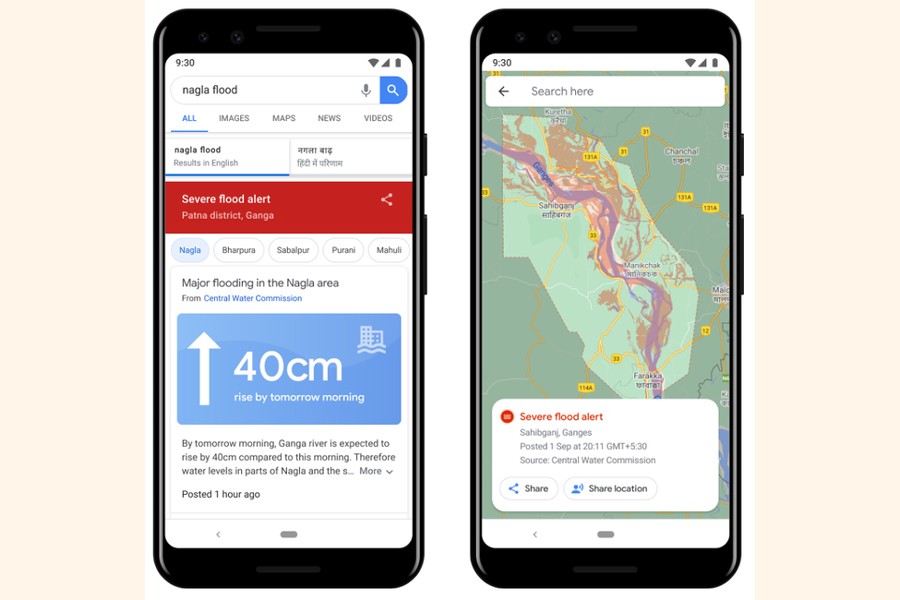The Google Flood Forecasting Initiative has partnered with the Bangladesh Water Development Board to bring Google's warnings and services to Bangladesh, which experiences more flooding than any other country in the world.
Google currently covers more than 40 million people in Bangladesh, and the world's largest search engine is working to extend this to the whole country, according to Google Flood Forecasting Initiative.
For several years, the Google Flood Forecasting Initiative has been working with governments of Bangladesh and India to develop systems that predict when and where flooding will occur-and keep people safe and informed.
This year's long-term floods in Bangladesh have affected the paddy and jute crops more than any other crops in the country. Besides, summer vegetables and maize are in the second position on the crop damage list, according to the final report of the Ministry of Agriculture on the damage of crops across the country due to the raging floods.
The final report from the Ministry of Agriculture shows that the total estimated cost of damage to crops across the country is Tk 13.23 billion.
Experts believe had there been a strong early warning and forecasting system, the losses would have been minimized to a large extent.
"In recent months, we've been expanding our forecasting models and services in partnership with the Indian Central Water Commission. In June, just in time for the monsoon season, we reached an important milestone: our systems now extend to the whole of India, with Google technology being used to improve the targeting of every alert the government sends. This means we can help better protect more than 200 million people across more than 250,000 square kilometres-more than 20 times our coverage last year. To date, we've sent out around 30 million notifications to people in flood-affected areas."
In flood-prone areas Google uses its models to help government alerts reach the right people.
"Much of this work is centered on India, where floods are a serious risk for hundreds of millions of people. Today, we're providing an update on how we're expanding and improving these efforts, as well as a new partnership we've formed with the International Federation of the Red Cross and Red Crescent Societies."
Around 37 per cent of Bangladesh's total area was flooded this year, said Prof AKM Saiful Islam of BUET's Institute of Water and Flood Management, after analysing satellite images.
Over 5.0 million people of 150 upazilas in 31 districts were affected by the flood, said the latest report of National Disaster Response Coordination Centre.
In 1998, around 68 per cent of the country was inundated, 61 per cent in 1988, 42 per cent in 2007 and 2017, and 38 per cent in 2004, Prof Saiful mentioned.
In collaboration with Yale, Google has been visiting flood-affected areas and doing research to better understand what information people need, how they use it to protect themselves, and what we can do to make that information more accessible.
"One survey we conducted found that 65 per cent of people who receive flood warnings before the flooding begins take action to protect themselves or their assets (such as evacuating or moving their belongings). But we've also found there's a lot more we could be doing to help-including getting alerts to people faster, and providing additional information about the severity of floods".
Google is providing people with information about flood depth: when and how much flood waters are likely to rise. And in areas where Google can produce depth maps throughout the floodplain, the Google is sharing information about depth in the user's village or area.
"We've also overhauled the way our alerts look and function to make sure they're useful and accessible for everyone. We now provide the information in different formats, so that people can both read their alerts and see them presented visually; we've added support for Hindi, Bengali and seven other local languages; we've made the alert more localized and accurate; and we now allow for easy changes to language or location."
In addition to improving our alerts, Google.org has started a collaboration with the International Federation of Red Cross and Red Crescent Societies. This partnership aims to build local networks that can get disaster alert information to people who wouldn't otherwise receive smartphone alerts directly.
Of course, for all the progress we've made with alert technology, there are still a lot of challenges to overcome. With the flood season still in full swing in India and Bangladesh, Covid-19 has delayed critical infrastructure work, added to the immense pressure on first responders and medical authorities, and disrupted the in-person networks that many people still rely on for advance notice when a flood is on the way.
There's much more work ahead to strengthen the systems that so many vulnerable people rely on-and expand them to reach out to more people in flood-affected areas. Along with our partners around the world, we need to continue developing, maintaining and improving technologies and digital tools to help protect communities and save lives of teeming millions.


